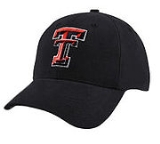
List of hats and headgear
Encyclopedia
This is an incomplete list of headgear
(that is, anything worn on the head), both modern and historical.
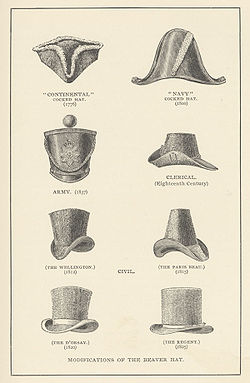
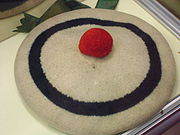
Hood
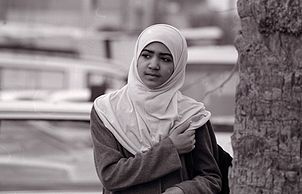


Headgear
Headgear, headwear or headdress is the name given to any element of clothing which is worn on one's head.Headgear serve a variety of purposes:...
(that is, anything worn on the head), both modern and historical.
Hats
| Type | Image |
|---|---|
| Akubra Akubra Akubra is an Australian brand of bush hat, whose wide-brimmed styles are a distinctive part of Australian culture, especially in rural areas. The name is believed to be derived from an Aboriginal word for head covering.... |
 |
| Aviator hat Aviator hat An aviator hat, also known as a Bomber Hat, is a usually leather cap with large ear-flaps, a chin strap and, often, a short brim that is commonly turned up at the front to show the lining . It is often worn with goggles... |
|
| Balmoral Balmoral bonnet The Balmoral is a traditional Scottish hat that can be worn as part of formal or informal Highland dress. Dating back to at least the 16th century, it takes the form of a knitted, soft wool cap with a flat crown... |
|
| Baseball cap Baseball cap A baseball cap is a type of soft cap with a rounded stiff brim. The front of the cap typically contains designs or logos of sports teams ,... |
 |
| Batting helmet Batting helmet A batting helmet is the protective headgear worn by batters in the game of baseball or softball. It is meant to protect the batter's head from errant pitches thrown by the pitcher... |
 |
| Beanie Beanie A beanie is a head-hugging brimless cap with or without a visor that was once popular among school boys.-Description:In the United States of America, beanies are made by triangular sections of cloth joined by a button at the crown and seamed together around the sides.They can also be made from... or skully and or visor beanie. |
|
| Beaver hat Beaver hat A beaver hat is a hat made from felted beaver fur. They were fashionable across much of Europe during the period 1550-1850 because the soft yet resilient material could be easily combed to make a variety of hat shapes... |
 |
| Beret Beret A beret is a soft, round, flat-crowned hat, designated a "cap", usually of woven, hand-knitted wool, crocheted cotton, or wool felt, or acrylic fiber.... |
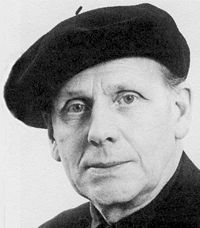 |
| Boater Boater Boater may refer to:*Boater, a type of hat*Boater, one of the first disposable diapers*Someone involved in boating... (also basher, skimmer, cady, katie, somer, or sennit hat) |
 |
| Bobble hat Bobble hat A Bobble hat or Bobble cap is a colloquial term for a knit beanie or tuque trimmed with a yarn "bobble" or pom-pom upon the crown. Bobble hats are generally considered utilitarian cold weather wear... |
|
| Boonie hat Boonie hat A boonie hat, also known as a bush hat, is a form of wide-brim hat commonly used by military forces. Its design is similar to a bucket hat but with a stiffer brim. Often a fabric tape band of 'branch loops' is sewn around the crown of the hat. This 'foliage ring' is meant to hold additional... |
|
| Bowler Bowler hat The bowler hat, also known as a coke hat, derby , billycock or bombin, is a hard felt hat with a rounded crown originally created in 1849 for the English soldier and politician Edward Coke, the younger brother of the 2nd Earl of Leicester... or Derby |
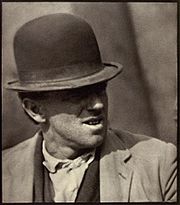 |
| Bucket hat Bucket hat A bucket hat, or fishing hat, is a soft cotton hat with a wide and downwards sloping brim which is worn by both men and women. The brim offers shade from the sun for the eyes and face. The hat is usually made from heavy-duty cotton fabric such as denim or canvas... also fishing hat, ratting hat (UK) or Dixie Cup hat (US) |
 |
| Busby Busby Busby is the English name for the Hungarian prémes csákó or kucsma, a military head-dress made of fur, worn by Hungarian hussars. In its original Hungarian form the busby was a cylindrical fur cap, having a bag of coloured cloth hanging from the top. The end of this bag was attached to the right... |
.jpg) |
| Capuchon Capuchon A capuchon is a cone-shaped ceremonial hat worn during the Mardi Gras celebration in the Cajun areas of southwestern Louisiana, known as the Courir de Mardi Gras. The rural celebration is based on early begging rituals, similar to those still celebrated by mummers, wassailers and celebrants of... |
|
| Chilote cap Chilote cap thumb|200px|Picture of a common design of Chilote capsA Chilote cap is woven cap typical of Chiloé Archipelago. The caps are made of coarse raw wool and has usually a pom-pon at the top... |
|
| Chupalla Chupalla The chupalla is a traditional Chilean horseman's hat made of straw. Many people in rural areas of Central Chile use it as well. In addition, it is often used when dancing the cueca and during Chilean rodeos.... |
 |
| Cloche hat Cloche hat The cloche hat is a fitted, bell-shaped hat for women that was invented by milliner Caroline Reboux in 1908, became especially popular during the 1920s, and continued to be commonly seen until about 1933. Cloche is the French word for "bell".... |
 |
| Cricket cap Cricket cap A cricket cap is a type of soft cap, often made from felt that is a traditional form of headwear for players of the game of cricket, regardless of age or gender. It is usually a tight-fitting skullcap, usually made of six or eight sections, with a small crescent shaped brim that points downwards... |
 |
| Combination cap, also peaked cap |  |
| Coonskin Cap Coonskin cap A coonskin cap is a hat fashioned from the skin and fur of a raccoon. The original coonskin cap consisted of the entire skin of the raccoon including its head and tail... |
 |
| Cowboy hat Cowboy hat The cowboy hat is a high-crowned, wide-brimmed hat best known as the defining piece of attire for the North American cowboy. Today it is worn by many people, and is particularly associated with ranch workers in the western and southern United States, western Canada and northern Mexico, with... , sometimes "Ten gallon hat" |
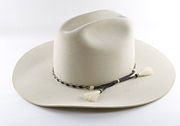 |
| Deerstalker Deerstalker A deerstalker is a type of hat that is typically worn in rural areas, often for hunting, especially deer stalking. Because of the hat's popular association with Sherlock Holmes, it is also a stereotypical hat of a detective.-Construction:... |
 |
| Fedora | 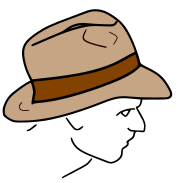 |
| Fez | 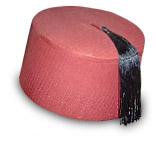 |
| Flat cap Flat cap A flat cap is a rounded men or women's cap with a small stiff brim in front. Cloths used to make the cap include original wool, tweed , and cotton. Less common materials may include leather. Cord flat caps are also worn in various colours. The inside of the cap is usually lined with silk for... , also bunnet, cloth cap, driver cap, golf cap, or Windsor cap |
 |
| Fruit hat Fruit hat A fruit hat is a festive and colorful hat type popularized by Carmen Miranda and associated with warm locales. This type of hat has been worn by fashionistas, in films, by comic strip characters, and for Halloween.-History:... |
 |
| Garrison cap Garrison cap A Side cap is a foldable military cap with straight sides and a creased or hollow crown sloping to the back where it is parted. It is known as a garrison cap , a wedge cap , or officially field service cap, , but it is more generally known as the side cap.It follows the style which... or side cap |
|
| Homburg |  |
| Greek fisherman's cap John Lennon hat The Greek fisherman's cap is often associated with seamanship and marine situations. It has become popular amongst the public in general, rather than staying isolated as an occupational hat. One example of it being put in prominence of popular culture was when it was worn by John Lennon... , also captain's cap |
|
| Karakul | |
| Kepi Kepi The kepi is a cap with a flat circular top and a visor or peak . Etymologically, the word is a borrowing of the French képi, itself a respelling of the Alemannic Käppi: a diminutive form of Kappe, meaning "cap".... |
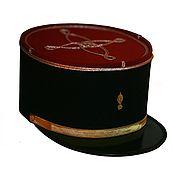 |
| Kippah Kippah A kippah or kipa , also known as a yarmulke , kapele , is a hemispherical or platter-shaped head cover, usually made of cloth, often worn by Orthodox Jewish men to fulfill the customary requirement that their head be covered at all times, and sometimes worn by both men and, less frequently, women... , also kippa, yarmulke or skullcap, Jewish traditional |
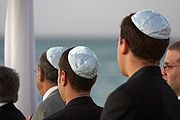 |
| Kofia Kofia (hat) The kofia is a brimless cylindrical cap with a flat crown, worn by men in East Africa, especially Swahili-speaking cultures. Kofia is a Swahili word that means hat. The kofia is worn with a dashiki, a colorful African shirt which is called a kitenge shirt in some regions of East Africa. In... , worn in East Africa East Africa East Africa or Eastern Africa is the easterly region of the African continent, variably defined by geography or geopolitics. In the UN scheme of geographic regions, 19 territories constitute Eastern Africa:... |
|
| Kufi Kufi A kufi or kufi cap is a brimless, short, rounded cap worn by many populations in West Africa of all religions and throughout the African diaspora.-African and African-American Usage:... , traditional cap worn by men of African descent, including the "Zulu crown". |
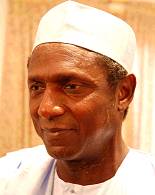 |
| Muir cap, the traditional leather biker-style cap worn by leathermen | |
| Nasaq, the crocheted headgear of some Canadian Canada Canada is a North American country consisting of ten provinces and three territories. Located in the northern part of the continent, it extends from the Atlantic Ocean in the east to the Pacific Ocean in the west, and northward into the Arctic Ocean... Inuit Inuit The Inuit are a group of culturally similar indigenous peoples inhabiting the Arctic regions of Canada , Denmark , Russia and the United States . Inuit means “the people” in the Inuktitut language... |
|
| Nightcap | |
| Newsboy cap Newsboy cap The newsboy cap or newsy cap is a casual-wear cap similar in style to the flat cap. Sometimes also referred to as the: Baker Boy, Apple Cap, Eight Panel, Cabbie, Jay Gatsby , Fisherman's Cap, Pageboy and Lundberg Stetson.It has the same overall shape and stiff peak in front as a flat cap, but the... , also Gatsby cap |
|
| Pakol | |
| Pork pie hat Pork pie hat A pork pie hat is a type of hat made of felt or straw. It is a type of fedora which has a cylindrical crown and flattish top. This style of crown is called a "telescopic crown", but the hat overall resembles the boater hat. It is short and has an indentation all the way around its top, allowing... |
 |
| Rogatywka Rogatywka Rogatywka is the Polish generic name for an asymmetrical, peaked, four-pointed cap used by various Polish military formations throughout the ages. It is a distant relative of its 18th century predecessor, konfederatka , although similar caps has been used by light cavalry since 14th century... |
|
| Šajkača Šajkaca The Šajkača is the Serbian national hat or cap.-History:The Šajkača originated in the 18th century. It was originally worn by the Serbian river fleet as a military headgear in the service of the Habsburg Empire around the Danube and Sava Rivers... |
 |
| Salakot Salakot The salakot is a traditional wide-brimmed hat in the Philippines. It is usually made of either rattan or reeds. It is one of the traditional hats worn by Filipinos besides the conical Asian hat which is worn widely in East Asia and other Southeast Asian countries.An ancient tradition recounts that... |
 |
| Skullcap Skullcap Skullcap or skull cap may refer to:* Calvaria , in anatomy, the top part of the skull* Headgear:** A Kippah or yarmulke, a small cloth skullcap worn by Orthodox Jewish men and some Jewish women... |
|
| Sombrero Sombrero Sombrero in English refers to a type of wide-brimmed hat originating in Mexico. In Spanish, however, it is the generic word for "hat", which originates from "sombra", meaning "shade".... |
|
| Straw hat Straw hat A straw hat is a brimmed hat that is woven out of straw or reeds. The hat is designed to protect the head from the sun and against heatstroke, but straw hats were also used in fashion and as a decorative element of a uniform.- Manufacture :... |
|
| Student cap Student cap In various European countries, student caps of different types are or have been worn, either as a marker of a common identity, as is the case in the Nordic countries, or to identify the bearer as member of a smaller corporation within the larger group of students, as is the case with the caps worn... |
 |
| Tam Tam (cap) The rastacap is a tall, round, usually crocheted cap, which is often brightly coloured. It is most commonly associated with the pat as a way for Rastafarians and others with dreadlocks to tuck their locks away, but may be worn for various reasons by Rastas and non-Rastas... , or Tam o'Shanter |
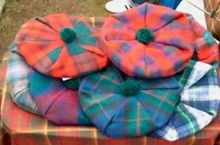 |
| Taqiya Taqiyah (cap) The taqiyah is a short, rounded cap worn by some observant Muslim men. When worn by itself, the taqiyah can be any color. When worn under the keffiyah scarf, it is always white. Some Muslims wrap the turban around the cap. The turban is called an imama in Arabic... , also tagiyah or Topi |
 |
| Top hat Top hat A top hat, beaver hat, high hat silk hat, cylinder hat, chimney pot hat or stove pipe hat is a tall, flat-crowned, broad-brimmed hat, predominantly worn from the latter part of the 18th to the middle of the 20th century... (also, Topper) |
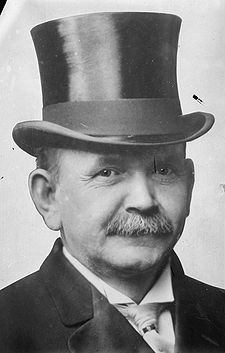 |
| Trilby Trilby A trilby hat is a type of fedora. The trilby is viewed as the rich man's favored hat; it is commonly called the "brown trilby" in England and is much seen at the horse races. It is described as a "crumpled" fedora... |
|
| Tubeteika Tubeteika A tubeteika or tübätäy is a Central Asian cap, today worn in Tajikistan, Kazakhstan, Kyrgyzstan, and Uzbekistan, as well as in Muslim-populated regions of Russia . The tubeteika is worn typically by the Turkic ethnic groups of the region. It bears some superficial resemblance to the yurt, another... |
 |
| Tuque Tuque A – variously known as a knit hat or stocking cap among other names – is a knitted cap, originally of wool though now often of synthetic fibers, that is designed to provide warmth in winter... , also knit hat, knit cap, sock cap, stocking cap, watch cap, toboggan, ski cap or skull cap |
 |
| Turban Turban In English, Turban refers to several types of headwear popularly worn in the Middle East, North Africa, Punjab, Jamaica and Southwest Asia. A commonly used synonym is Pagri, the Indian word for turban.-Styles:... |
|
| Vueltiao Sombrero Vueltiao The sombrero vueltiao or sombrero vueltiado is a traditional hat from Colombia and one of its symbols. It is made out of Gynerium sagittatum known locally as caña flecha, a type of cane that grows in the region... A Colombian typical hat with woven and sewn dried tinted palm strips and indigenous figures. |
|
| Ushanka Ushanka An ushanka , also known as a trooper, is a Russian fur cap with ear flaps that can be tied up to the crown of the cap, or tied at the chin to protect the ears, jaw and lower chin from the cold. The thick dense fur also offers some protection against blunt impacts to the head... |
|
| Zucchetto Zucchetto The zucchetto , a/k/a pileolus in Latin and calotte/calotta in France, Italy and Hispanic nations, is a small skullcap worn by clerics of the Roman Catholic Church, as well as in Anglicanism.... |
 |
Hats worn in the past, or rarely worn today

Men's
- Aar bonnet
- Verbano English Cap
- Anthony Eden hatAnthony Eden hatAn "Anthony Eden" hat, or simply an "Anthony Eden", was a silk-brimmed, black felt Homburg of the kind favoured in the 1930s by Anthony Eden, later 1st Earl of Avon . Eden was a Cabinet Minister in the British National Government, holding the offices of Lord Privy Seal from 1934–35 and Foreign...
- BeaverBeaver hatA beaver hat is a hat made from felted beaver fur. They were fashionable across much of Europe during the period 1550-1850 because the soft yet resilient material could be easily combed to make a variety of hat shapes...
- Beefeaters' hat
- BicorneBicorneThe bicorne or bicorn is an archaic form of hat widely adopted in the 1790s as an item of uniform by European and American military and naval officers...
- BoaterBoater (hat)A boater is a kind of men's formal summer hat....
, also basher, skimmer - Boss of the plainsBoss of the plainsThe Boss of the Plains was a lightweight all-weather hat designed by John B. Stetson for the demands of the American west. It was intended to be durable, waterproof and elegant...
- BowlerBowler hatThe bowler hat, also known as a coke hat, derby , billycock or bombin, is a hard felt hat with a rounded crown originally created in 1849 for the English soldier and politician Edward Coke, the younger brother of the 2nd Earl of Leicester...
, also coke hat, billycock, boxer, bun hat, derby - Cabbage-tree hatCabbage-tree hatCabbage tree hats Cabbage tree hats Cabbage tree hats (also known as cabbage palm hats originate from Australia from around 1875-1880. Answers.com describes the hat as "a broad-brimmed hat made from cabbage-tree leaves."...
a hat woven from leaves of the cabbage tree - CapotainCapotainA capotain, capatain or copotain is a tall-crowned, narrow-brimmed, slightly conical hat, usually black, worn by men and women from the 1590s into the mid-seventeenth century in England and northwestern Europe...
(and women) - a tall conical hatPointed hatPointed hats have been a distinctive item of headgear of a wide range of cultures throughout history. Though often suggesting an ancient Indo-European tradition, they were also traditionally worn by women of Lapland, the Japanese, the Mi'kmaq people of Atlantic Canada, and the Huastecs of Veracruz...
, 17th century, usually black - also, copotain, copatain - Caroline - 17th Century
- Carriage hat - 1780s-1820s
- CaubeenCaubeenThe caubeen is an Irish beret. It was formerly worn by peasants; however, it has since been adopted as the headdress of the Irish regiments of the British and Commonwealth armies, where its formal name is the "Bonnet, Irish, Green".-Name:...
- Irish hat - Cavalier hatCavalier hatA cavalier hat is a wide-brimmed hat trimmed with an ostrich plume. Cavalier hats get their name from supporters of King Charles I during the English Civil War, known as cavaliers. Besides just fashionable hats, cavaliers also wore extravagant clothing....
, also chevaliers, wide brimmed hat trimmed with ostrich plumes - Chapeau-bras, also chapeau de bras - 18th to early-19th-century folding bicorneBicorneThe bicorne or bicorn is an archaic form of hat widely adopted in the 1790s as an item of uniform by European and American military and naval officers...
hat carried under one arm - ChaperonChaperon (headgear)Chaperon was a form of hood or, later, highly versatile hat worn in all parts of Western Europe in the Middle Ages. Initially a utilitarian garment, it first grew a long partly decorative tail behind, and then developed into a complex, versatile and expensive headgear after what was originally the...
adaptable late Middle Ages "dead-chicken" hat - Chimney-pot hat, also lum-hat, Victorian, also worn by clerics in the Greek Orthodox Church
- Cocked hat
- DeerstalkerDeerstalkerA deerstalker is a type of hat that is typically worn in rural areas, often for hunting, especially deer stalking. Because of the hat's popular association with Sherlock Holmes, it is also a stereotypical hat of a detective.-Construction:...
, hunting cap with fold-down ears, associated with Sherlock HolmesSherlock HolmesSherlock Holmes is a fictional detective created by Scottish author and physician Sir Arthur Conan Doyle. The fantastic London-based "consulting detective", Holmes is famous for his astute logical reasoning, his ability to take almost any disguise, and his use of forensic science skills to solve...
, Elmer FuddElmer FuddElmer J. Fudd/Egghead is a fictional cartoon character and one of the most famous Looney Tunes characters, and the de facto archenemy of Bugs Bunny. He has one of the more disputed origins in the Warner Bros. cartoon pantheon . His aim is to hunt Bugs, but he usually ends up seriously injuring...
, and Holden CaulfieldHolden CaulfieldHolden Caulfield is the 16-to-17 years old protagonist of author J. D. Salinger's The Catcher in the Rye. He is universally recognized for his resistance to growing older and desire to protect childhood innocence...
. - FedoraFedora (hat)A fedora is a men's felt hat. In reality, "fedora" describes most any men's hat that does not already have another name; quite a few fedoras have famous names of their own including the famous Trilby....
- FezFez (clothing)The fez , or tarboosh is a felt hat either in the shape of a red truncated cone or in the shape of a short cylinder made of kilim fabric. Both usually have tassels...
- Hats and headwear, ancient Chinese hats
- HomburgHomburg (hat)A homburg is a felt hat, a Tyrolean hat-style fedora, characterized by a single dent running down the center of the crown and a stiff brim shaped in a "kettle curl". The Homburg is a stiff, formal felt hat....
- KolpikKolpikA kolpik is a type of traditional headgear worn in families of some Chassidic Rebbes , by unmarried children on Shabbat, and by some Rebbes on special occasions. It is made from brown fur, as opposed to a spodik, worn by Polish chassidic dynasties, which is fashioned out of black fur.The word...
- Panama hatPanama hatA Panama hat is a traditional brimmed hat of Ecuadorian origin that is made from the plaited leaves of the toquilla straw plant...
- PeciPeciThe peci or songkok is a cap widely worn in Indonesia, Brunei, Malaysia, Singapore, the southern Philippines and southern Thailand, mostly among Muslim males. It has the shape of a truncated cone, almost always made of black or embroidered felt, cotton or velvet. It is ordinarily worn with the...
- Papakha
- Pith HelmetPith helmetThe pith helmet is a lightweight cloth-covered helmet made of cork or pith...
stereotypical Safari/Jungle Explorer Hat - Pork piePork pie hatA pork pie hat is a type of hat made of felt or straw. It is a type of fedora which has a cylindrical crown and flattish top. This style of crown is called a "telescopic crown", but the hat overall resembles the boater hat. It is short and has an indentation all the way around its top, allowing...
- ShtreimelShtreimelA shtreimel is a fur hat worn by many married haredi Jewish men, particularly members of Hasidic groups, on Shabbat and Jewish holidays and other festive occasions. In Jerusalem, the shtreimel is also worn by 'Yerushalmi' Jews...
- SpodikSpodikA spodik is a tall fur hat worn by some Hasidic Jews, particularly members of sects originating in Congress Poland. Spodiks are to be distinguished from shtreimels, which are a similar type of fur hat worn by Hasidim...
- SombreroSombreroSombrero in English refers to a type of wide-brimmed hat originating in Mexico. In Spanish, however, it is the generic word for "hat", which originates from "sombra", meaning "shade"....
- Sudra
- TiaraPapal TiaraThe Papal Tiara, also known incorrectly as the Triple Tiara, or in Latin as the Triregnum, in Italian as the Triregno and as the Trirègne in French, is the three-tiered jewelled papal crown, supposedly of Byzantine and Persian origin, that is a prominent symbol of the papacy...
, a hat traditionally worn worn by the PopePopeThe Pope is the Bishop of Rome, a position that makes him the leader of the worldwide Catholic Church . In the Catholic Church, the Pope is regarded as the successor of Saint Peter, the Apostle...
, which has been abandoned in recent decades, in favor of the MitreMitreThe mitre , also spelled miter, is a type of headwear now known as the traditional, ceremonial head-dress of bishops and certain abbots in the Roman Catholic Church, as well as in the Anglican Communion, some Lutheran churches, and also bishops and certain other clergy in the Eastern Orthodox...
. - Top hatTop hatA top hat, beaver hat, high hat silk hat, cylinder hat, chimney pot hat or stove pipe hat is a tall, flat-crowned, broad-brimmed hat, predominantly worn from the latter part of the 18th to the middle of the 20th century...
, also stovepipe hat - TricorneTricorneThe tricorne or tricorn is a style of hat that was popular during the 18th century, falling out of style by 1800. At the peak of its popularity, the tricorne was worn as civilian dress and as part of military and naval uniforms...
- TrilbyTrilbyA trilby hat is a type of fedora. The trilby is viewed as the rich man's favored hat; it is commonly called the "brown trilby" in England and is much seen at the horse races. It is described as a "crumpled" fedora...
Women's
- Bandeau hat
- BeaverBeaver hatA beaver hat is a hat made from felted beaver fur. They were fashionable across much of Europe during the period 1550-1850 because the soft yet resilient material could be easily combed to make a variety of hat shapes...
- Beehive
- Bergère hatBergère hatA bergère hat is a flat-brimmed straw hat with a shallow crown, usually trimmed with ribbon and flowers. It could be worn in various ways with the brim folded back or turned up or down at whim....
- Bloomer
- Bongrace - a velvet-covered headdress, stiffened with buckram - 16th century
- Breton
- Capeline - 18th/19th century
- CapotainCapotainA capotain, capatain or copotain is a tall-crowned, narrow-brimmed, slightly conical hat, usually black, worn by men and women from the 1590s into the mid-seventeenth century in England and northwestern Europe...
(and men) - a tall conical hat, 17th century, usually black - also, copotain, copatain - Cart-wheel hat - low crown, wide stiff brim
- Cocktail hatCocktail hatA cocktail hat is a small, extravagant hat for a woman. It is usually a component of evening wear and is intended as an alternative to a large-brimmed hat. These hats are often decorated with beads, jewels or feathers, as well as a veil...
- Gainsborough hat -a very large hat often elaboratly decorated with plumes, flowers, and trinkets.
- HenninHenninThe hennin was a headdress in the shape of a cone or "steeple", or truncated cone worn in the late Middle Ages by European women of the nobility. They were most common in Burgundy and France, but also elsewhere, especially at the English courts, and in Northern Europe, Hungary and Poland. They...
- KokoshnikKokoshnikThe kokoshnik is a traditional Russian head-dress worn by women and girls to accompany the sarafan. It is patterned to match the style of the sarafan and can be pointed or round. It is tied at the back of the head with long thick ribbons in a large bow. The forehead is sometimes decorated with...
- Nón lá, VietnamVietnamVietnam – sometimes spelled Viet Nam , officially the Socialist Republic of Vietnam – is the easternmost country on the Indochina Peninsula in Southeast Asia. It is bordered by China to the north, Laos to the northwest, Cambodia to the southwest, and the South China Sea –...
. - Nón quai thao, VietnamVietnamVietnam – sometimes spelled Viet Nam , officially the Socialist Republic of Vietnam – is the easternmost country on the Indochina Peninsula in Southeast Asia. It is bordered by China to the north, Laos to the northwest, Cambodia to the southwest, and the South China Sea –...
- OchipokOchipokThe Ochipok was a married woman's headdress as part of traditional Ukrainian folk dress, often decorated with Ukrainian embroidery.Ochipok is a cap that covers the entire head with a slit in the back and laces that pull it tightly around the head....
- Tantour
Unclassified

- Archer's bonnet
- Balibuntal - straw hat from the Philippines
- Castor or caster - beaver or rabbit
- Chip hat
- ClocheCloche hatThe cloche hat is a fitted, bell-shaped hat for women that was invented by milliner Caroline Reboux in 1908, became especially popular during the 1920s, and continued to be commonly seen until about 1933. Cloche is the French word for "bell"....
- Cockle hat
- Cony or coney
- Coolie hat
- Copintank, also copentank, coptank, copitaine
- Cordies
- CossackCossackCossacks are a group of predominantly East Slavic people who originally were members of democratic, semi-military communities in what is today Ukraine and Southern Russia inhabiting sparsely populated areas and islands in the lower Dnieper and Don basins and who played an important role in the...
hat - CrinolineCrinolineCrinoline was originally a stiff fabric with a weft of horse-hair and a warp of cotton or linen thread. The fabric first appeared around 1830, but by 1850 the word had come to mean a stiffened petticoat or rigid skirt-shaped structure of steel designed to support the skirts of a woman’s dress into...
, also gibus-hat - Demicastor hat
- Directoire
- Dolly Varden
- Fan-tail hat
- Flat
- Gainsborough
- Garbo hat
- GaribaldiGiuseppe GaribaldiGiuseppe Garibaldi was an Italian military and political figure. In his twenties, he joined the Carbonari Italian patriot revolutionaries, and fled Italy after a failed insurrection. Garibaldi took part in the War of the Farrapos and the Uruguayan Civil War leading the Italian Legion, and...
hat - Gipsy hat
- Gossamer hat
- Grebe hat
- Halo-brim hat
- Hat Terrai Gurkha, worn only by Gurkha ContingentGurkha ContingentThe Gurkha Contingent is a line department of the Singapore Police Force. Members of the GC are trained to be highly-skilled and are selected for their display of strong discipline and dedication in their tasks...
officers in SingaporeSingaporeSingapore , officially the Republic of Singapore, is a Southeast Asian city-state off the southern tip of the Malay Peninsula, north of the equator. An island country made up of 63 islands, it is separated from Malaysia by the Straits of Johor to its north and from Indonesia's Riau Islands by the... - HomburgHomburg (hat)A homburg is a felt hat, a Tyrolean hat-style fedora, characterized by a single dent running down the center of the crown and a stiff brim shaped in a "kettle curl". The Homburg is a stiff, formal felt hat....
; a black Homburg was also known as an "Anthony EdenAnthony Eden hatAn "Anthony Eden" hat, or simply an "Anthony Eden", was a silk-brimmed, black felt Homburg of the kind favoured in the 1930s by Anthony Eden, later 1st Earl of Avon . Eden was a Cabinet Minister in the British National Government, holding the offices of Lord Privy Seal from 1934–35 and Foreign...
" (after the politician Anthony EdenAnthony EdenRobert Anthony Eden, 1st Earl of Avon, KG, MC, PC was a British Conservative politician, who was Prime Minister from 1955 to 1957...
) - Hunting hat
- JaapiJaapiJaapi is a traditional Assamese headgear or hat of Assam, India.-About Jaapi:Typical regular use Jaapi is made out of tightly woven bamboo and/or cane and taku paat . The name, jaapi comes after the word jaap, bundle of taku leaves...
of Assam, India - Jerry
- KausiaKausiaA kausia was an ancient Macedonian flat hat which was worn during the Hellenistic period but perhaps even before the time of Alexander the Great and was also used in lion hunting and as a protection against the sun by the poorer classes in Rome....
- Kevenhuller
- Kiss-me-quick hat
- Leghorn hat
- Mandarin hat
- Manilla hat
- Marquis hat
- Matinée hat
- Merry Widow hat
- Moab
- MonteraMonteraA montera is the hat traditionally worn by many males and females in the folk costumes of the Iberian peninsula.It has come to name also but not exclusively the ones used by bullfighters, introduced to the ritual event in 1835 by Francisco 'Paquiro' Montes as accompaniment to the traje de luces, or...
- Mourning hat
- Mousquetaire
- Muff-box
- Müller hat
- Mushroom
- PetasosPetasosA petasos or petasus is a sun hat of Thessalian origin worn by the ancient Greeks, often in combination with the chlamys cape. It was usually made of wool felt, leather or straw, with a broad, floppy brim. It was worn primarily by farmers and travellers, and was considered characteristic of rural...
- Pill box hat
- Sugar loaf
- Veiled hat, also bird cage hat
Caps worn by men in the past, or rarely worn today
- Aviator's cap
- BarretinaBarretinaA barretina is a traditional hat that was frequently worn by men in parts of the Christian cultures of the Mediterranean sea such as Catalonia, the Valencian Community, the Balearic Islands, Provence, Corsica, Sicily, Sardinia, part of Naples, part of the Balkans and parts of Portugal.In Catalonia...
- CapelineCapelineCapeline is the name given to two distinct types of post-Renaissance helmetThe first was a steel skullcap usually worn by archers that continued to be worn into the 17th century by musketeers and horsemen who wished to wear fashionable broad-brimmed hats but also retain some level of protection...
- a steel skullcap worn by archers in the Middle Ages - Cap'n'bells ("Jester cap" or "jester hat")
- Hooker-doon, a cloth cap with a peak, in Scotland,
- Icelandic tail-capIcelandic tail-capThe Icelandic tail-cap or skotthúfa is a typical part of the Icelandic national costume. Originally it was only worn by men, but starting in the 18th century women started to wear it along with the peysa, a men's jacket with a single row of buttons creating the proto-peysuföt...
- Pileus (hat)Pileus (hat)The pileus — also pilleus or pilleum — was a cap worn by sailors in Ancient Greece and later copied by Ancient Rome. It was a brimless, felt cap, somewhat similar to a fez...
- Phrygian capPhrygian capThe Phrygian cap is a soft conical cap with the top pulled forward, associated in antiquity with the inhabitants of Phrygia, a region of central Anatolia. In the western provinces of the Roman Empire it came to signify freedom and the pursuit of liberty, perhaps through a confusion with the pileus,...
- Smoking capSmoking capSmoking caps are caps worn by men while smoking to stop the hair from smelling of smoke. They also kept the head warm. They were popular in the period 1840-1880, usually worn by gentlemen in the privacy of their home. They are similar to the smoking jacket, though their use, even in Victorian...
- Sou'wester, or "Cape Ann," a flexible waterproof hat traditionally worn by sailors
Caps worn by women in the past
- Icelandic tail-capIcelandic tail-capThe Icelandic tail-cap or skotthúfa is a typical part of the Icelandic national costume. Originally it was only worn by men, but starting in the 18th century women started to wear it along with the peysa, a men's jacket with a single row of buttons creating the proto-peysuföt...
- Juliet capJuliet capA Juliet cap is a small open-work crocheted or mesh cap, often decorated with pearls, beads or jewels, and chiefly worn with evening dresses or as bridal wear. The cap is named after the heroine of Shakespeare's Romeo and Juliet....
- Mob-cap
- Pinner
Bonnets for women
- Cabriolet
- CapoteCapote-People:* American writer Truman Capote** Capote , a film starring Philip Seymour Hoffman as Truman Capote* Capote Band of Utes, a branch of the Ute people-Other:* Capote , Champion American Thoroughbred racehorse...
- soft crown, rigid brim, 19th century - Chip bonnet
- Gypsy bonnet - shallow to flat crown, saucer shaped, and worn by tying it on with either a scarf or sash, under the chin, or at the nape of the neck - 19th Century
- Kiss-me-quick
- Leghorn bonnet
- Mourning bonnet
- Poke bonnet - Early 19th Century, "Christmas Carol" style, with a cylindrical crown and broad funnel brim
- Ugly - a kind of retractable visorVisorA visor is a surface that protects the eyes, such as shading them from the sun or other bright light or protecting them from objects....
that could be attached to bonnets for extra protection from the sun, 19th century
Bonnets for men
- GlengarryGlengarryThe glengarry bonnet is a traditional boat-shaped hat without a peak made of thick-milled woollen material with a toorie on top, a rosette cockade on the left, and ribbons hanging down behind...
bonnet - Feather bonnetFeather bonnetThe feather bonnet is a type of military headdress used mainly by the Scottish Highland infantry regiments of the British Army from about 1763 until the outbreak of World War I. It is now mostly worn by pipers and drummers in various bands throughout the world...
, the traditional military headgear of many Scottish Highland regiments - Tam o'shanterTam o'shanter (hat)A Tam o' Shanter is a Scottish style hat originally worn by men. The hat is named after a character in a poem written by Robert Burns in 1790...
- Frob head spectacular
- Jobby head
- Balmoral bonnetBalmoral bonnetThe Balmoral is a traditional Scottish hat that can be worn as part of formal or informal Highland dress. Dating back to at least the 16th century, it takes the form of a knitted, soft wool cap with a flat crown...
HoodHood (headgear)A hood is a kind of headgear that covers most of the head and neck and sometimes the face. They may be worn for protection from the environment, for fashion, as a form of traditional dress or uniform, to prevent the wearer from seeing or to prevent the wearer from being identified.-History and...
s
- Bonnet head
- Chaperon (headgear)Chaperon (headgear)Chaperon was a form of hood or, later, highly versatile hat worn in all parts of Western Europe in the Middle Ages. Initially a utilitarian garment, it first grew a long partly decorative tail behind, and then developed into a complex, versatile and expensive headgear after what was originally the...
adaptable late Middle Ages "dead-chicken" hood and hat - Flemish hood
- French hoodFrench hoodA French hood is a type of woman's headgear popular in Western Europe in the sixteenth century.The French hood is characterized by a rounded shape, contrasted with the angular "English" or gable hood. It is worn over a coif, and has a black veil attached to the back. It was introduced to England...
- Gable hoodGable hoodA gable hood, English hood or gable headdress is an English woman's headdress of c. 1500–1550, so-called because its pointed shape resembles the gable of a house...
- Hood - modern or historical, attached to tops or shirtShirtA shirt is a cloth garment for the upper body. Originally an undergarment worn exclusively by men, it has become, in American English, a catch-all term for almost any garment other than outerwear such as sweaters, coats, jackets, or undergarments such as bras, vests or base layers...
s, overcoatOvercoatAn overcoat is a type of long coat intended to be worn as the outermost garment. Overcoats usually extend below the knee, but are sometimes mistakenly referred to as topcoats, which are short coats that end at or above the knees. Topcoats and overcoats together are known as outercoats...
s, cloakCloakA cloak is a type of loose garment that is worn over indoor clothing and serves the same purpose as an overcoat; it protects the wearer from the cold, rain or wind for example, or it may form part of a fashionable outfit or uniform. Cloaks are as old as human history; there has nearly always been...
s, etc. - CapiroteCapiroteA capirote is a pointy hat of conical form that is used in Spain.Historically, the capirote was a cardboard cone that flagellants in Spain would use...
, AKA The Ku Klux KlanKu Klux KlanKu Klux Klan, often abbreviated KKK and informally known as the Klan, is the name of three distinct past and present far-right organizations in the United States, which have advocated extremist reactionary currents such as white supremacy, white nationalism, and anti-immigration, historically...
hood originally worn by SpanishSpainSpain , officially the Kingdom of Spain languages]] under the European Charter for Regional or Minority Languages. In each of these, Spain's official name is as follows:;;;;;;), is a country and member state of the European Union located in southwestern Europe on the Iberian Peninsula...
NazareneNazarene movementThe name Nazarene was adopted by a group of early 19th century German Romantic painters who aimed to revive honesty and spirituality in Christian art...
s - Mary Queen of Scots
- Medieval hood
- Mourning hood
- Riding hood
- Stuart hoodStuart HoodStuart Hood is a Scottish novelist, translator and a former British television producer and Controller of the BBC's most popular television network, BBC One. He was born in Edzell, Angus, Scotland.-Life:...
- Bongrace, the stiffened back of the hood when flipped over the forehead to provide shade; also a separate headdress to provide shade, worn with a hood or coif, Tudor/Elizabethan
Headbands, headscarves, wimples

- AbayaAbayaThe abaya "cloak" , sometimes also called an aba, is a simple, loose over-garment, essentially a robe-like dress, worn by some women in parts of the Islamic world including in Turkey, North Africa and the Arabian Peninsula....
- Buknuk
- ChadorChadorA chādor or chādar is an outer garment or open cloak worn by many Iranian women and female teenagers in public spaces. Wearing this garment is one possible way in which a Muslim woman can follow the Islamic dress code known as ḥijāb. A chador is a full-body-length semicircle of fabric that is...
- Chaperon (headgear)Chaperon (headgear)Chaperon was a form of hood or, later, highly versatile hat worn in all parts of Western Europe in the Middle Ages. Initially a utilitarian garment, it first grew a long partly decorative tail behind, and then developed into a complex, versatile and expensive headgear after what was originally the...
adaptable late Middle Ages "dead-chicken" hat, hood and scarf - CoifCoifA coif is a close fitting cap that covers the top, back, and sides of the head.- History :Coifs were worn by all classes in England and Scotland from the Middle Ages to the early seventeenth century .Tudor and earlier coifs are usually made of unadorned white linen and tied under...
- Crispine 13th Century European women's style of padding hair in a net and headband
- DupattaDupattaDupatta Dupatta(Urdu: دوپٹا, Hindi: दुपट्टा, Bengali: ওড়না, Sindhi: پوتي, Tamil:துப்பட்ட) Dupatta(Urdu: دوپٹا, Hindi: दुपट्टा, Bengali: ওড়না, Sindhi: پوتي, Tamil:துப்பட்ட) (alternative names include chadar (in Pakistan), orni/odhni, chunri, chunni, orna, and pacheri, is a long,...
, also shayla or milfeh - Khimar
- HeadbandHeadbandA headband is a clothing accessory worn in the hair or around the forehead, usually to hold hair away from the face or eyes. Headbands generally consist of a loop of elastic material or a horseshoe-shaped piece of flexible plastic or metal...
- HeadscarfHeadscarfHeadscarves or head scarves are scarves covering most or all of the top of a woman's hair and her head. Headscarves may be worn for a variety of purposes, such as for warmth, for sanitation, for fashion or social distinction; with religious significance, to hide baldness, out of modesty, or other...
, also khimar, hijabHijabThe word "hijab" or "'" refers to both the head covering traditionally worn by Muslim women and modest Muslim styles of dress in general....
, ohrni - NemesNemesThe nemes was the striped headcloth worn by pharaohs in ancient Egypt. It covered the whole crown and back of the head and nape of the neck and had two large flaps which hung down behind the ears and in front of both shoulders. It was sometimes combined with the double crown, as it is on the...
- SnoodSnood (headgear)A snood is historically a type of European female headgear, or in modern times a tubular neck scarf. In the most common form the headgear resembles a close-fitting hood worn over the back of the head...
- TagelmustTagelmustA tagelmust is an indigo dyed cotton garment with the appearance of both a veil and a turban. The cloth may exceed ten meters in length. It is worn mostly by Tuareg men, but is sometimes used by men in other neighbouring ethnic groups, such as the Hausa or Songhai...
, also cheich - VeilVeilA veil is an article of clothing, worn almost exclusively by women, that is intended to cover some part of the head or face.One view is that as a religious item, it is intended to show honor to an object or space...
- WimpleWimpleA wimple is a garment worn around the neck and chin, and which usually covers the head. Its use developed among women in early medieval Europe . At many stages of medieval culture it was unseemly for a married woman to show her hair...
Masks, veils and headgear that covers the face
- See MaskMaskA mask is an article normally worn on the face, typically for protection, disguise, performance or entertainment. Masks have been used since antiquity for both ceremonial and practical purposes...
for a fuller list of masks. - Balaclava (helmet) or ski mask
- Boushiya
- BurqaBurqaA burqa is an enveloping outer garment worn by women in some Islamic religion to cover their bodies in public places. The burqa is usually understood to be the woman's loose body-covering , plus the head-covering , plus the face-veil .-Etymology:A speculative and unattested etymology...
, also burka, burga, burqua - Diving maskDiving maskA diving mask is an item of diving equipment that allows scuba divers, free-divers, and snorkelers to see clearly underwater. When the human eye is in direct contact with water as opposed to air, its normal environment, light entering the eye is refracted by a different angle and the eye is unable...
- Full-face diving mask
- Gas maskGas maskA gas mask is a mask put on over the face to protect the wearer from inhaling airborne pollutants and toxic gases. The mask forms a sealed cover over the nose and mouth, but may also cover the eyes and other vulnerable soft tissues of the face. Some gas masks are also respirators, though the word...
- NiqabNiqabA niqab is a cloth which covers the face, worn by some Muslim women as a part of sartorial hijāb...
- VeilVeilA veil is an article of clothing, worn almost exclusively by women, that is intended to cover some part of the head or face.One view is that as a religious item, it is intended to show honor to an object or space...
- Wedding veil
- VisorVisorA visor is a surface that protects the eyes, such as shading them from the sun or other bright light or protecting them from objects....
Women's
- Alice band
- Bandanna
- BandeauBandeau- General Attire :A bandeau , is a strapless garment worn around a woman's breasts. It may be fastened in the front or back or be sufficiently elastic so as to have no fastener at all. In a strict sense a bandeau has but two edges, although it is sometimes manufactured with a detachable halter...
- Bongrace - a shade for the face, sometimes part of a hood, or a separate garment worn with a hood or coif; Tudor/Elizabethan
- FascinatorFascinatorA fascinator is a headpiece, a style of millinery. The word originally referred to a fine, lacy head covering akin to a shawl and made from wool or lace, but mostly feathers.The term had fallen almost into disuse by the 1970s...
- Mitre, also miter
- PerakPerak (headdress)A perak is a headdress typically worn by the old aristocracy in the Himalayan Ladakh region of Asia. It is composed of a strap of leather studded with semi-precious stones, such as lapis lazuli and turquoise.-Symbolism:...
- visorVisorA visor is a surface that protects the eyes, such as shading them from the sun or other bright light or protecting them from objects....
- wreathWreath (attire)A wreath is a headdress made from leaves, grasses, flowers or branches. It is typically worn in festive occasions and on holy days and has a long history and association with ancient pageants and ceremonies. Outside of occasional use, the wreath can also used as a crown...
Men's
- Arab headdress
- A white cap or skullcap: * taqiyaTaqiyah (cap)The taqiyah is a short, rounded cap worn by some observant Muslim men. When worn by itself, the taqiyah can be any color. When worn under the keffiyah scarf, it is always white. Some Muslims wrap the turban around the cap. The turban is called an imama in Arabic...
, also tagiyah, gahfiah - covered by the flowing scarf: ghutrah, also gutra, smagh, shmagh, kaffiyeh, kufiyyeh, keffiyehKeffiyehThe keffiyeh/kufiya , also known as a ghutrah , ' , mashadah , shemagh or in Persian chafiye , Kurdish cemedanî and Turkish puşi, is a traditional Arab headdress fashioned from a square, usually cotton, scarf. It is typically worn by Arab men, as well as some Kurds...
, keffiyah, kaffiye, keffiya - Kept in place by a band around the cap and scarf: igal, also egal, agal, aqal, ogal
- A white cap or skullcap: * taqiya
- BandanaBandanaBandana can refer to:*Another name for a kerchief*Bandana *Bandana *Bandana, Kentucky, a small town in the United States*Y Bandana, a Welsh alternative rock band.**Y Bandana , their self-titled debut album....
, also bandanna - VisorVisorA visor is a surface that protects the eyes, such as shading them from the sun or other bright light or protecting them from objects....
- Do-ragDo-ragA do-rag, also spelled doo-rag, du-rag, durag, is a piece of cloth used to cover the head. According to the Oxford English Dictionary and Merriam-Webster the term derives from do as in hairdo.- History :...
- Stocking cap
- ToporTopor (headgear)A topor is a type of conical headgear traditionally worn by grooms as part of the Bengali Hindu wedding ceremony. The topor is typically fragile, made of sholapith and white in colour....
- Bengali men's wedding headgear
Jeweled

- CoronetCoronetA coronet is a small crown consisting of ornaments fixed on a metal ring. Unlike a crown, a coronet never has arches.The word stems from the Old French coronete, a diminutive of coronne , itself from the Latin corona .Traditionally, such headgear is – as indicated by the German equivalent...
- CrownCrown (headgear)A crown is the traditional symbolic form of headgear worn by a monarch or by a deity, for whom the crown traditionally represents power, legitimacy, immortality, righteousness, victory, triumph, resurrection, honour and glory of life after death. In art, the crown may be shown being offered to...
- Imperial Crown of IndiaImperial Crown of IndiaThe Imperial Crown of India was the crown of the Sovereign as Emperor of India during the time of the British Raj. The crown is housed with, but is not part of, the Crown Jewels of the United Kingdom.-History:...
- Imperial State CrownImperial State CrownThe Imperial State Crown is one of the Crown Jewels of the United Kingdom.- Design :The Crown is of a design similar to St Edward's Crown: it includes a base of four crosses pattée alternating with four fleurs-de-lis, above which are four half-arches surmounted by a cross. Inside is a velvet cap...
- St Edward's Crown
- Holy Crown of Hungary
- Imperial Crown of India
- TiaraTiaraA tiara is a form of crown. There are two possible types of crown that this word can refer to.Traditionally, the word "tiara" refers to a high crown, often with the shape of a cylinder narrowed at its top, made of fabric or leather, and richly ornamented. It was used by the kings and emperors of...
- Papal tiaraPapal TiaraThe Papal Tiara, also known incorrectly as the Triple Tiara, or in Latin as the Triregnum, in Italian as the Triregno and as the Trirègne in French, is the three-tiered jewelled papal crown, supposedly of Byzantine and Persian origin, that is a prominent symbol of the papacy...
- DiademDiadem (personal wear)A diadem is a type of crown, specifically an ornamental headband worn by Eastern monarchs and others as a badge of royalty. The word derives from the Greek "διάδημα" , "band" or "fillet", from "διαδέω" , "I bind round", or "I fasten"....
Catholic
- BirettaBirettaThe biretta is a square cap with three or four peaks or horns, sometimes surmounted by a tuft. Traditionally the three peaked biretta is worn by Roman Catholic clergy and some Anglican and Lutheran clergy. The four peaked biretta is worn as academic dress by those holding a doctoral degree from a...
- CamauroCamauroA camauro is a cap traditionally worn by the Pope of the Catholic Church....
- Cappello romanoCappello romanoA cappello romano or saturno is a hat with a wide, circular brim and a rounded rim worn outdoors in some countries by Catholic clergy, when dressed in a cassock. It is made of either beaver fur or felt, and lined in white silk...
- GaleroGaleroA galero in the Catholic Church is a large, broad-brimmed tasseled hat worn by clergy. Over the centuries the galero was eventually limited in use to individual cardinals as a crown symbolizing the title of Prince of the Church...
- Papal tiaraPapal TiaraThe Papal Tiara, also known incorrectly as the Triple Tiara, or in Latin as the Triregnum, in Italian as the Triregno and as the Trirègne in French, is the three-tiered jewelled papal crown, supposedly of Byzantine and Persian origin, that is a prominent symbol of the papacy...
- ZucchettoZucchettoThe zucchetto , a/k/a pileolus in Latin and calotte/calotta in France, Italy and Hispanic nations, is a small skullcap worn by clerics of the Roman Catholic Church, as well as in Anglicanism....
- MitreMitreThe mitre , also spelled miter, is a type of headwear now known as the traditional, ceremonial head-dress of bishops and certain abbots in the Roman Catholic Church, as well as in the Anglican Communion, some Lutheran churches, and also bishops and certain other clergy in the Eastern Orthodox...
- MantillaMantillaA mantilla is a lace or silk veil or shawl worn over the head and shoulders, often over a high comb, popular with women in Spain. It is particularly associated with traditional devotional practices among women in Catholicism.-History:...
Jewish
- Havalim (חֲבָליִם) ropes that are referenced in Kings I 20:31. Used as a sign of mourning.
- Pe’er mentioned in Ezekiel 24: 17;23. In verse 17, Ezekiel commands the Israelites to “wrap their” Pe’er’s around their heads. In verse 23, Ezekiel tells the Israelite that their Pe’er's "shall remain on your heads.” ("Pe'er" (which translates into "splendor") is usually used to refer to phylacteries (tefillinTefillinTefillin also called phylacteries are a set of small black leather boxes containing scrolls of parchment inscribed with verses from the Torah, which are worn by observant Jews during weekday morning prayers. Although "tefillin" is technically the plural form , it is loosely used as a singular as...
)) - Migbahat was likely a cone-shaped Turban. This turban was likely only worn in the context of the priesthood and is cited in Exodus 27:20-30.
- MitznefetMitznefetThe priestly mitre or turban was the head covering worn by the Jewish High Priest when he served in the Tabernacle and the Temple in Jerusalem.-Etymology:...
was most likely a classic circular turban. This is derived from the fact that Hebrew word MitznefetMitznefetThe priestly mitre or turban was the head covering worn by the Jewish High Priest when he served in the Tabernacle and the Temple in Jerusalem.-Etymology:...
comes from the root "to wrap." This turban was likely only worn in the context of the priesthood and is cited in Exodus 27:20-30. - Sudra (סודרא) is a headdress, similar to the keffiyah worn by Jewish men in the ancient near-east.
- KippahKippahA kippah or kipa , also known as a yarmulke , kapele , is a hemispherical or platter-shaped head cover, usually made of cloth, often worn by Orthodox Jewish men to fulfill the customary requirement that their head be covered at all times, and sometimes worn by both men and, less frequently, women...
or yarmulke - KashketKashketA Kashket is a cap, usually made of felt, worn mainly by Hasidic children at present. Prior to the Second World War it was worn by almost all Polish Hasidic Jews...
- ShtreimelShtreimelA shtreimel is a fur hat worn by many married haredi Jewish men, particularly members of Hasidic groups, on Shabbat and Jewish holidays and other festive occasions. In Jerusalem, the shtreimel is also worn by 'Yerushalmi' Jews...
- SpodikSpodikA spodik is a tall fur hat worn by some Hasidic Jews, particularly members of sects originating in Congress Poland. Spodiks are to be distinguished from shtreimels, which are a similar type of fur hat worn by Hasidim...
- KolpikKolpikA kolpik is a type of traditional headgear worn in families of some Chassidic Rebbes , by unmarried children on Shabbat, and by some Rebbes on special occasions. It is made from brown fur, as opposed to a spodik, worn by Polish chassidic dynasties, which is fashioned out of black fur.The word...
- SheitelSheitelSheitel is the Yiddish word for a wig or half-wig worn by Orthodox Jewish married women in order to conform with the requirement of Jewish Law to cover their hair. This practice is part of the modesty-related dress standard called tzniut. The word seems to be derived from the German word...
is a wig worn by some married women in order to maintain marital modesty in public
Military and police
- BarretinaBarretinaA barretina is a traditional hat that was frequently worn by men in parts of the Christian cultures of the Mediterranean sea such as Catalonia, the Valencian Community, the Balearic Islands, Provence, Corsica, Sicily, Sardinia, part of Naples, part of the Balkans and parts of Portugal.In Catalonia...
- Beefeaters'Yeomen WardersThe Yeomen Warders of Her Majesty’s Royal Palace and Fortress the Tower of London, and Members of the Sovereign's Body Guard of the Yeoman of the Guard Extraordinary, popularly known as the Beefeaters, are ceremonial guardians of the Tower of London...
hat - BearskinBearskinA bearskin is a tall fur cap, usually worn as part of a ceremonial military uniform. Traditionally, the bearskin was the headgear of grenadiers, and is still worn by grenadier and guards regiments in various armies.-Origins:...
- BeretBeretA beret is a soft, round, flat-crowned hat, designated a "cap", usually of woven, hand-knitted wool, crocheted cotton, or wool felt, or acrylic fiber....
- Bersagliere
- BicorneBicorneThe bicorne or bicorn is an archaic form of hat widely adopted in the 1790s as an item of uniform by European and American military and naval officers...
- Boonie hatBoonie hatA boonie hat, also known as a bush hat, is a form of wide-brim hat commonly used by military forces. Its design is similar to a bucket hat but with a stiffer brim. Often a fabric tape band of 'branch loops' is sewn around the crown of the hat. This 'foliage ring' is meant to hold additional...
- BusbyBusbyBusby is the English name for the Hungarian prémes csákó or kucsma, a military head-dress made of fur, worn by Hungarian hussars. In its original Hungarian form the busby was a cylindrical fur cap, having a bag of coloured cloth hanging from the top. The end of this bag was attached to the right...
- Campaign hatCampaign hatA campaign cover is a broad-brimmed felt or straw hat, with a high crown, pinched symmetrically at the four corners .It is associated with the New Zealand Army, the Royal Canadian...
, also drill instructor hat, drill sergeant hat, ranger hat, sergeant hat, Smokey Bear hat - CaubeenCaubeenThe caubeen is an Irish beret. It was formerly worn by peasants; however, it has since been adopted as the headdress of the Irish regiments of the British and Commonwealth armies, where its formal name is the "Bonnet, Irish, Green".-Name:...
- Chapeau-brasChapeau-Mainland Europe:"Chapeau" is a French term signifying a hat or other covering for the head. In mainland European heraldry, it is used as a mark of ecclesiastical dignity, especially that of cardinals, which is called the red chapeau...
, also chapeau de bras - 18th to early-19th-century folding bicorneBicorneThe bicorne or bicorn is an archaic form of hat widely adopted in the 1790s as an item of uniform by European and American military and naval officers...
hat carried under one arm - Custodian helmetCustodian helmetCustodian helmet or centurion helmet, technically known as a 'Home Office pattern helmet', is a helmet worn by many policemen in England and Wales.-History:...
, headwear of the British police officer, ranks of SergeantSergeantSergeant is a rank used in some form by most militaries, police forces, and other uniformed organizations around the world. Its origins are the Latin serviens, "one who serves", through the French term Sergent....
and ConstableConstableA constable is a person holding a particular office, most commonly in law enforcement. The office of constable can vary significantly in different jurisdictions.-Etymology:... - Envelope Busby, worn by Officer Cadets of the Royal Military College of Canada
- Feather bonnetFeather bonnetThe feather bonnet is a type of military headdress used mainly by the Scottish Highland infantry regiments of the British Army from about 1763 until the outbreak of World War I. It is now mostly worn by pipers and drummers in various bands throughout the world...
- Flying helmet - closely fitting solid helmet designed to resist impacts within the cockpit of military aircraft - colloquially known as a 'bone dome
- Garrison capGarrison capA Side cap is a foldable military cap with straight sides and a creased or hollow crown sloping to the back where it is parted. It is known as a garrison cap , a wedge cap , or officially field service cap, , but it is more generally known as the side cap.It follows the style which...
, also campaign cap, cunt cap, flight cap, garrison hat, overseas cap - GlengarryGlengarryThe glengarry bonnet is a traditional boat-shaped hat without a peak made of thick-milled woollen material with a toorie on top, a rosette cockade on the left, and ribbons hanging down behind...
, also Glengarry bonnet, Glengarry cap - Hardee hatHardee hatThe Hardee hat, also known as the Model 1858 Dress Hat and sometimes nicknamed the "Jeff Davis", was the regulation dress hat for enlisted men in the Union Army during the American Civil War. The Hardee hat was also worn by Confederate soldiers. However, most soldiers found the black felt hat to...
- HelmetHelmetA helmet is a form of protective gear worn on the head to protect it from injuries.Ceremonial or symbolic helmets without protective function are sometimes used. The oldest known use of helmets was by Assyrian soldiers in 900BC, who wore thick leather or bronze helmets to protect the head from...
- Jeep capJeep capThe jeep cap originally the US Army issued M1941 wool knit cap is generally like a toboggan cap with a short, baseball cap-like brim attached to it, made mostly from knitted yarn, originally wool but now more often acrylic...
- Kartus - a peakless cap worn by the Swedish army during the Great Northern WarGreat Northern WarThe Great Northern War was a conflict in which a coalition led by the Tsardom of Russia successfully contested the supremacy of the Swedish Empire in northern Central Europe and Eastern Europe. The initial leaders of the anti-Swedish alliance were Peter I the Great of Russia, Frederick IV of...
. Called the Kabuds by the Danish and Norwegians and the Kartooze by the Russians, nations which also adopted it - KepiKepiThe kepi is a cap with a flat circular top and a visor or peak . Etymologically, the word is a borrowing of the French képi, itself a respelling of the Alemannic Käppi: a diminutive form of Kappe, meaning "cap"....
- Mirliton - a high tubular concave hat with a "wing", worn by hussars in the 18th and early 19th centuries
- Mitre
- Patrol capPatrol capA patrol cap, also known as a field cap is a soft cap with a stiff, rounded visor, and flat top, worn by the military personnel of some countries in the field when a combat helmet is not required.-M1951 Field Cap and Ridgeway Cap:...
- Peaked capPeaked capA peaked cap, forage cap, barracks cover, or combination cap is a form of headgear worn by the armed forces of many nations and also by many uniformed civilian organizations such as law enforcement agencies...
, also known as service cap or combination cap - PickelhaubePickelhaubeThe Pickelhaube , also "Pickelhelm," was a spiked helmet worn in the 19th and 20th centuries by German military, firefighters, and police...
- a spiked German leather helmet. - Sailor capSailor capA sailor cap is a round, flat visorless hat worn by sailors in many of the world's navies. A tally, an inscribed black silk ribbon, is tied around the base which usually bears the name of a ship or a navy. The cap may be further embellished with a badge, cockade or other accessory...
, also known as "white hat" or "dixie cup" in the US Navy - ShakoShakoA shako is a tall, cylindrical military cap, usually with a peak or visor and sometimes tapered at the top...
- Slouch hatSlouch hatA slouch hat is a wide-brimmed felt or cloth hat with a chinstrap, most commonly worn as part of a military uniform. It is a survivor of the felt hats worn by certain 18th century armies. Since then, the slouch hat has been worn by military personnel from many nations including Australia, Britain,...
- Tarleton helmetBanastre TarletonGeneral Sir Banastre Tarleton, 1st Baronet, GCB was a British soldier and politician.He is today probably best remembered for his military service during the American War of Independence. He became the focal point of a propaganda campaign claiming that he had fired upon surrendering Continental...
- A leather helmet with a large crest. Popular with cavalryCavalryCavalry or horsemen were soldiers or warriors who fought mounted on horseback. Cavalry were historically the third oldest and the most mobile of the combat arms...
and light infantryLight infantryTraditionally light infantry were soldiers whose job was to provide a skirmishing screen ahead of the main body of infantry, harassing and delaying the enemy advance. Light infantry was distinct from medium, heavy or line infantry. Heavy infantry were dedicated primarily to fighting in tight...
in the late 18th and early 19th century. Named after British military commander, Banastre Tarleton. - Tricorn - Three-cornered hat synonymous with the 18th century. Worn by musketeers, dragoons and cuirassiers of all western armies, also often by French grenadiers (which was uncommon considering that most grenadiers at the time wore mitres or bearskinBearskinA bearskin is a tall fur cap, usually worn as part of a ceremonial military uniform. Traditionally, the bearskin was the headgear of grenadiers, and is still worn by grenadier and guards regiments in various armies.-Origins:...
s).
Officials and civil workers
- Qing official headwear
- Ming official headwearMing official headwearThe headwear of a Han Chinese official during Ming Dynasty China consisted of a black hat with two wing-like flaps of thin, oval shaped boards on each side called the wushamao...
- Tang official headwearTang official headwearthumb|Tang Emperor Xuanzong wearing Tang style headwearThe headwear of Tang dynasty officials consisted of a black hat with two wing-like flaps. However, contrary to headwear of the Song dynasty, the flaps droop down.-See also:*Qing official headwear...
- Song official headwearSong official headwearthumb| [[Emperor Shenzong of Song]] wearing Song official headwearThe headwear of Song dynasty officials consisted of a black hat with two wing-like flaps. The thin flaps are stiff and straight, and could extend up to almost a meter each.-See also:...
Other specialist headgear
- Chef's hatChef's uniformThe traditional chef's uniform includes a toque , white double-breasted jacket, and checkered pants. It is a common uniform in the Western world....
, also toque blanche, or more familiarly, toque - CoronetCoronetA coronet is a small crown consisting of ornaments fixed on a metal ring. Unlike a crown, a coronet never has arches.The word stems from the Old French coronete, a diminutive of coronne , itself from the Latin corona .Traditionally, such headgear is – as indicated by the German equivalent...
- Cowboy hatCowboy hatThe cowboy hat is a high-crowned, wide-brimmed hat best known as the defining piece of attire for the North American cowboy. Today it is worn by many people, and is particularly associated with ranch workers in the western and southern United States, western Canada and northern Mexico, with...
- CrownCrown (headgear)A crown is the traditional symbolic form of headgear worn by a monarch or by a deity, for whom the crown traditionally represents power, legitimacy, immortality, righteousness, victory, triumph, resurrection, honour and glory of life after death. In art, the crown may be shown being offered to...
- Casquette or Cycling CapCasquetteCasquette is French for "cap". In cycling jargon, it is used to refer to the traditional peaked cotton cap worn by racing cyclists.With the introduction of compulsory cycle helmets for massed-start racing, casquettes have become less common, but most professional race outfits still have them...
- Fire-hat
- Gas maskGas maskA gas mask is a mask put on over the face to protect the wearer from inhaling airborne pollutants and toxic gases. The mask forms a sealed cover over the nose and mouth, but may also cover the eyes and other vulnerable soft tissues of the face. Some gas masks are also respirators, though the word...
- Green eyeshadeGreen eyeshadeGreen eyeshades are a type of visor that were worn most often from the late 19th century to the middle 20th century by accountants, telegraphers, copy editors and others engaged in vision-intensive, detail-oriented occupations in order to lessen eyestrain and other effects of early incandescent...
- Mortarboard
- Night capNightcap (garment)A nightcap is a warm cloth cap worn while sleeping, often with pajamas or a nightgown. They are similar to winter 'beanies' worn in cold climates. They were common in northern Europe before central heating was available, when homes were cold at night....
- Nurse's capNurse's capA nurse's cap or nursing cap is part of the female nurse's uniform, introduced early in the history of the profession. The cap's original purpose was to keep the nurse's hair neatly in place and present a modest appearance...
- Energy domeEnergy domeEnergy dome refers to the red terraced headgear first worn by Devo during their Freedom of Choice years. Other incorrect names include "power dome" and "flowerpot" . Energy Domes have been a regular part of Devo's stage costumes since 1980, worn in their 1982, 1988, and 1990 tours, as well as most...
- Printer's hatPrinter's hatA printer's hat is a traditional, box-shaped, folded paper hat, formerly worn by craft tradesmen such as carpenters, masons, painters and printers....
also pressman's hat - SantaSanta ClausSanta Claus is a folklore figure in various cultures who distributes gifts to children, normally on Christmas Eve. Each name is a variation of Saint Nicholas, but refers to Santa Claus...
's hat - Scrum-cap
- Shower capShower capA shower cap is a cap worn while showering or bathing, to protect hair from becoming wet.Many are produced by joining two layers of fabric together in order to make the shower cap not only waterproof but aesthetic also. However, simpler ones are purely made from one layer of a waterproof material,...
, a flexible plastic covering to protect the hair from getting wet, as used when taking a shower. - Space helmet
- Swimming cap, also "swim cap" and "bathing cap"
- Tin Foil hat
- ToporTopor (headgear)A topor is a type of conical headgear traditionally worn by grooms as part of the Bengali Hindu wedding ceremony. The topor is typically fragile, made of sholapith and white in colour....
- Bengali men's wedding headgear - VisorVisorA visor is a surface that protects the eyes, such as shading them from the sun or other bright light or protecting them from objects....
- Wedding veil
National dress; association with a country, people and religion

- Aso Oke HatAso Oke HatAn Aso Oke Hat is a traditional Yoruba hat that is made of hand woven African fabric, see Aso Oke fabric, cotton, velvet, or damask. In the Yoruba language, this hat is called a fila. Although these hats originated in Nigeria they are worn by all men of African descent. Typically, the top of the...
- Yoruba peopleYoruba peopleThe Yoruba people are one of the largest ethnic groups in West Africa. The majority of the Yoruba speak the Yoruba language... - BarretinaBarretinaA barretina is a traditional hat that was frequently worn by men in parts of the Christian cultures of the Mediterranean sea such as Catalonia, the Valencian Community, the Balearic Islands, Provence, Corsica, Sicily, Sardinia, part of Naples, part of the Balkans and parts of Portugal.In Catalonia...
- CatalanCataloniaCatalonia is an autonomous community in northeastern Spain, with the official status of a "nationality" of Spain. Catalonia comprises four provinces: Barcelona, Girona, Lleida, and Tarragona. Its capital and largest city is Barcelona. Catalonia covers an area of 32,114 km² and has an... - Bearskin hat
- BeretBeretA beret is a soft, round, flat-crowned hat, designated a "cap", usually of woven, hand-knitted wool, crocheted cotton, or wool felt, or acrylic fiber....
- French, BasqueBasque peopleThe Basques as an ethnic group, primarily inhabit an area traditionally known as the Basque Country , a region that is located around the western end of the Pyrenees on the coast of the Bay of Biscay and straddles parts of north-central Spain and south-western France.The Basques are known in the... - Bhatgaunle Topi - NepalNepalNepal , officially the Federal Democratic Republic of Nepal, is a landlocked sovereign state located in South Asia. It is located in the Himalayas and bordered to the north by the People's Republic of China, and to the south, east, and west by the Republic of India...
- BlangkonBlangkonA blangkon or belangkon is a traditional Javanese headdress worn by men and made of batik fabric. There are 4 different types of blangkons according to their shapes and origins: Ngayogyakarta blangkons, Surakarta blangkons, Kedu blangkons, and Banyumasan blangkons.-History:In ancient Javanese...
- Javanese and Sundanese peopleSundanese peopleThe Sundanese are an ethnic group native to the western part of the Indonesian island of Java. They number approximately 31 million, and are the second most populous of all the nation's ethncities. The Sundanese are predominantly Muslim... - Breton, also Bretonne
- ChupallaChupallaThe chupalla is a traditional Chilean horseman's hat made of straw. Many people in rural areas of Central Chile use it as well. In addition, it is often used when dancing the cueca and during Chilean rodeos....
- ChileChileChile ,officially the Republic of Chile , is a country in South America occupying a long, narrow coastal strip between the Andes mountains to the east and the Pacific Ocean to the west. It borders Peru to the north, Bolivia to the northeast, Argentina to the east, and the Drake Passage in the far...
an - Clop - RomanianRomaniansThe Romanians are an ethnic group native to Romania, who speak Romanian; they are the majority inhabitants of Romania....
- Coolie hat
- Coonskin hat - AmericanUnited StatesThe United States of America is a federal constitutional republic comprising fifty states and a federal district...
frontiersman - CossackCossackCossacks are a group of predominantly East Slavic people who originally were members of democratic, semi-military communities in what is today Ukraine and Southern Russia inhabiting sparsely populated areas and islands in the lower Dnieper and Don basins and who played an important role in the...
hat - Dogon hat - Dogon peopleDogon peopleThe Dogon are an ethnic group living in the central plateau region of Mali, south of the Niger bend near the city of Bandiagara in the Mopti region. The population numbers between 400,000 and 800,000 The Dogon are best known for their religious traditions, their mask dances, wooden sculpture and...
, West AfricaWest AfricaWest Africa or Western Africa is the westernmost region of the African continent. Geopolitically, the UN definition of Western Africa includes the following 16 countries and an area of approximately 5 million square km:-Flags of West Africa:... - FezFez (clothing)The fez , or tarboosh is a felt hat either in the shape of a red truncated cone or in the shape of a short cylinder made of kilim fabric. Both usually have tassels...
- Feathered headdress
- Four Winds hatFour Winds hatthumb|Four Winds hatThe Four Winds hat is one version of traditional man's hat of the Sami. The basis is a simple blue cylinder, decorated with a red band with braid patterns, but the top is a large, four-cornered star, colored bright blue with parts bright red and yellow...
- Fulani straw hat - Fula peopleFula peopleFula people or Fulani or Fulbe are an ethnic group spread over many countries, predominantly in West Africa, but found also in Central Africa and Sudanese North Africa...
, West AfricaWest AfricaWest Africa or Western Africa is the westernmost region of the African continent. Geopolitically, the UN definition of Western Africa includes the following 16 countries and an area of approximately 5 million square km:-Flags of West Africa:... - Glengarry bonnet
- Għonnella or Faldetta - MalteseMaltaMalta , officially known as the Republic of Malta , is a Southern European country consisting of an archipelago situated in the centre of the Mediterranean, south of Sicily, east of Tunisia and north of Libya, with Gibraltar to the west and Alexandria to the east.Malta covers just over in...
- Haida hat
- KofiaKofia (hat)The kofia is a brimless cylindrical cap with a flat crown, worn by men in East Africa, especially Swahili-speaking cultures. Kofia is a Swahili word that means hat. The kofia is worn with a dashiki, a colorful African shirt which is called a kitenge shirt in some regions of East Africa. In...
- Swahili peopleSwahili peopleThe Swahili people are a Bantu ethnic group and culture found in East Africa, mainly in the coastal regions and the islands of Kenya, Tanzania and north Mozambique. According to JoshuaProject, the Swahili number in at around 1,328,000. The name Swahili is derived from the Arabic word Sawahil,...
, East AfricaEast AfricaEast Africa or Eastern Africa is the easterly region of the African continent, variably defined by geography or geopolitics. In the UN scheme of geographic regions, 19 territories constitute Eastern Africa:... - KufiKufiA kufi or kufi cap is a brimless, short, rounded cap worn by many populations in West Africa of all religions and throughout the African diaspora.-African and African-American Usage:...
- West AfricaWest AfricaWest Africa or Western Africa is the westernmost region of the African continent. Geopolitically, the UN definition of Western Africa includes the following 16 countries and an area of approximately 5 million square km:-Flags of West Africa:... - Leopard cap - Igbo peopleIgbo peopleIgbo people, also referred to as the Ibo, Ebo, Eboans or Heebo are an ethnic group living chiefly in southeastern Nigeria. They speak Igbo, which includes various Igboid languages and dialects; today, a majority of them speak English alongside Igbo as a result of British colonialism...
, West AfricaWest AfricaWest Africa or Western Africa is the westernmost region of the African continent. Geopolitically, the UN definition of Western Africa includes the following 16 countries and an area of approximately 5 million square km:-Flags of West Africa:... - MandarinMandarin (bureaucrat)A mandarin was a bureaucrat in imperial China, and also in the monarchist days of Vietnam where the system of Imperial examinations and scholar-bureaucrats was adopted under Chinese influence.-History and use of the term:...
hat - ChineseHan ChineseHan Chinese are an ethnic group native to China and are the largest single ethnic group in the world.Han Chinese constitute about 92% of the population of the People's Republic of China , 98% of the population of the Republic of China , 78% of the population of Singapore, and about 20% of the... - Mokorotlo - Basotho/LesothoLesothoLesotho , officially the Kingdom of Lesotho, is a landlocked country and enclave, surrounded by the Republic of South Africa. It is just over in size with a population of approximately 2,067,000. Its capital and largest city is Maseru. Lesotho is a member of the Commonwealth of Nations. The name...
- Montenegrin capMontenegrin capThe Montenegrin cap is a cap traditionally worn by Montenegrins and Serbs of Montenegro. Originally worn by males, it is now not exclusively for them....
- Montenegrins, SerbsSerbsThe Serbs are a South Slavic ethnic group of the Balkans and southern Central Europe. Serbs are located mainly in Serbia, Montenegro and Bosnia and Herzegovina, and form a sizable minority in Croatia, the Republic of Macedonia and Slovenia. Likewise, Serbs are an officially recognized minority in... - Pakol - Pashtun peoplePashtun peoplePashtuns or Pathans , also known as ethnic Afghans , are an Eastern Iranic ethnic group with populations primarily between the Hindu Kush mountains in Afghanistan and the Indus River in Pakistan...
, AfghanistanAfghanistanAfghanistan , officially the Islamic Republic of Afghanistan, is a landlocked country located in the centre of Asia, forming South Asia, Central Asia and the Middle East. With a population of about 29 million, it has an area of , making it the 42nd most populous and 41st largest nation in the world... - Phrygian capPhrygian capThe Phrygian cap is a soft conical cap with the top pulled forward, associated in antiquity with the inhabitants of Phrygia, a region of central Anatolia. In the western provinces of the Roman Empire it came to signify freedom and the pursuit of liberty, perhaps through a confusion with the pileus,...
- RomanRoman EmpireThe Roman Empire was the post-Republican period of the ancient Roman civilization, characterised by an autocratic form of government and large territorial holdings in Europe and around the Mediterranean....
, FrenchFranceThe French Republic , The French Republic , The French Republic , (commonly known as France , is a unitary semi-presidential republic in Western Europe with several overseas territories and islands located on other continents and in the Indian, Pacific, and Atlantic oceans. Metropolitan France... - QelesheQelesheA qeleshe is a traditional skull cap, which is worn by Albanian men throughout Albania, in Kosovo, the Republic of Macedonia, Serbia, Montenegro, and in the Arbëresh villages in Italy....
- AlbanianAlbaniansAlbanians are a nation and ethnic group native to Albania and neighbouring countries. They speak the Albanian language. More than half of all Albanians live in Albania and Kosovo... - ŠajkačaŠajkacaThe Šajkača is the Serbian national hat or cap.-History:The Šajkača originated in the 18th century. It was originally worn by the Serbian river fleet as a military headgear in the service of the Habsburg Empire around the Danube and Sava Rivers...
- SerbianSerbsThe Serbs are a South Slavic ethnic group of the Balkans and southern Central Europe. Serbs are located mainly in Serbia, Montenegro and Bosnia and Herzegovina, and form a sizable minority in Croatia, the Republic of Macedonia and Slovenia. Likewise, Serbs are an officially recognized minority in... - SalakotSalakotThe salakot is a traditional wide-brimmed hat in the Philippines. It is usually made of either rattan or reeds. It is one of the traditional hats worn by Filipinos besides the conical Asian hat which is worn widely in East Asia and other Southeast Asian countries.An ancient tradition recounts that...
- FilipinoFilipino peopleThe Filipino people or Filipinos are an Austronesian ethnic group native to the islands of the Philippines. There are about 92 million Filipinos in the Philippines, and about 11 million living outside the Philippines .... - SariSariA sari or sareeThe name of the garment in various regional languages include: , , , , , , , , , , , , , is a strip of unstitched cloth, worn by females, ranging from four to nine metres in length that is draped over the body in various styles. It is popular in India, Bangladesh, Nepal,...
- IndiaIndiaIndia , officially the Republic of India , is a country in South Asia. It is the seventh-largest country by geographical area, the second-most populous country with over 1.2 billion people, and the most populous democracy in the world... - Shripech - Traditional Crown of Monarch of Nepal
- Slouch hatSlouch hatA slouch hat is a wide-brimmed felt or cloth hat with a chinstrap, most commonly worn as part of a military uniform. It is a survivor of the felt hats worn by certain 18th century armies. Since then, the slouch hat has been worn by military personnel from many nations including Australia, Britain,...
, also digger hat, Australian slouch hat - Songkok - Malaysia and Indonesia
- Tam o'shanterTam o'shanter (hat)A Tam o' Shanter is a Scottish style hat originally worn by men. The hat is named after a character in a poem written by Robert Burns in 1790...
- ScottishScotlandScotland is a country that is part of the United Kingdom. Occupying the northern third of the island of Great Britain, it shares a border with England to the south and is bounded by the North Sea to the east, the Atlantic Ocean to the north and west, and the North Channel and Irish Sea to the... - Top hatTop hatA top hat, beaver hat, high hat silk hat, cylinder hat, chimney pot hat or stove pipe hat is a tall, flat-crowned, broad-brimmed hat, predominantly worn from the latter part of the 18th to the middle of the 20th century...
- EnglishEnglandEngland is a country that is part of the United Kingdom. It shares land borders with Scotland to the north and Wales to the west; the Irish Sea is to the north west, the Celtic Sea to the south west, with the North Sea to the east and the English Channel to the south separating it from continental... - ToporTopor (headgear)A topor is a type of conical headgear traditionally worn by grooms as part of the Bengali Hindu wedding ceremony. The topor is typically fragile, made of sholapith and white in colour....
- Bengali men's wedding headgear - TurbanTurbanIn English, Turban refers to several types of headwear popularly worn in the Middle East, North Africa, Punjab, Jamaica and Southwest Asia. A commonly used synonym is Pagri, the Indian word for turban.-Styles:...
- TuqueTuqueA – variously known as a knit hat or stocking cap among other names – is a knitted cap, originally of wool though now often of synthetic fibers, that is designed to provide warmth in winter...
or toque - CanadianCanadaCanada is a North American country consisting of ten provinces and three territories. Located in the northern part of the continent, it extends from the Atlantic Ocean in the east to the Pacific Ocean in the west, and northward into the Arctic Ocean...
, esp. French-Canadian/QuébécoisFrench-speaking QuebecerFrench-speaking Quebecers are francophone residents of the Canadian province of Quebec.... - UshankaUshankaAn ushanka , also known as a trooper, is a Russian fur cap with ear flaps that can be tied up to the crown of the cap, or tied at the chin to protect the ears, jaw and lower chin from the cold. The thick dense fur also offers some protection against blunt impacts to the head...
- RussianRussiansThe Russian people are an East Slavic ethnic group native to Russia, speaking the Russian language and primarily living in Russia and neighboring countries.... - Welsh hatWelsh hatThe Welsh hat worn by women as part of Welsh national costume is a tall stovepipe-style hat, similar to a top hat, or the Pilgrim hat. It is still worn by women, and particularly schoolgirls, in Wales on St David's Day, but rarely on other occasions....
- Zulu crown - Zulu people, Southern AfricaSouthern AfricaSouthern Africa is the southernmost region of the African continent, variably defined by geography or geopolitics. Within the region are numerous territories, including the Republic of South Africa ; nowadays, the simpler term South Africa is generally reserved for the country in English.-UN...
, see kufiKufiA kufi or kufi cap is a brimless, short, rounded cap worn by many populations in West Africa of all religions and throughout the African diaspora.-African and African-American Usage:...
for information

